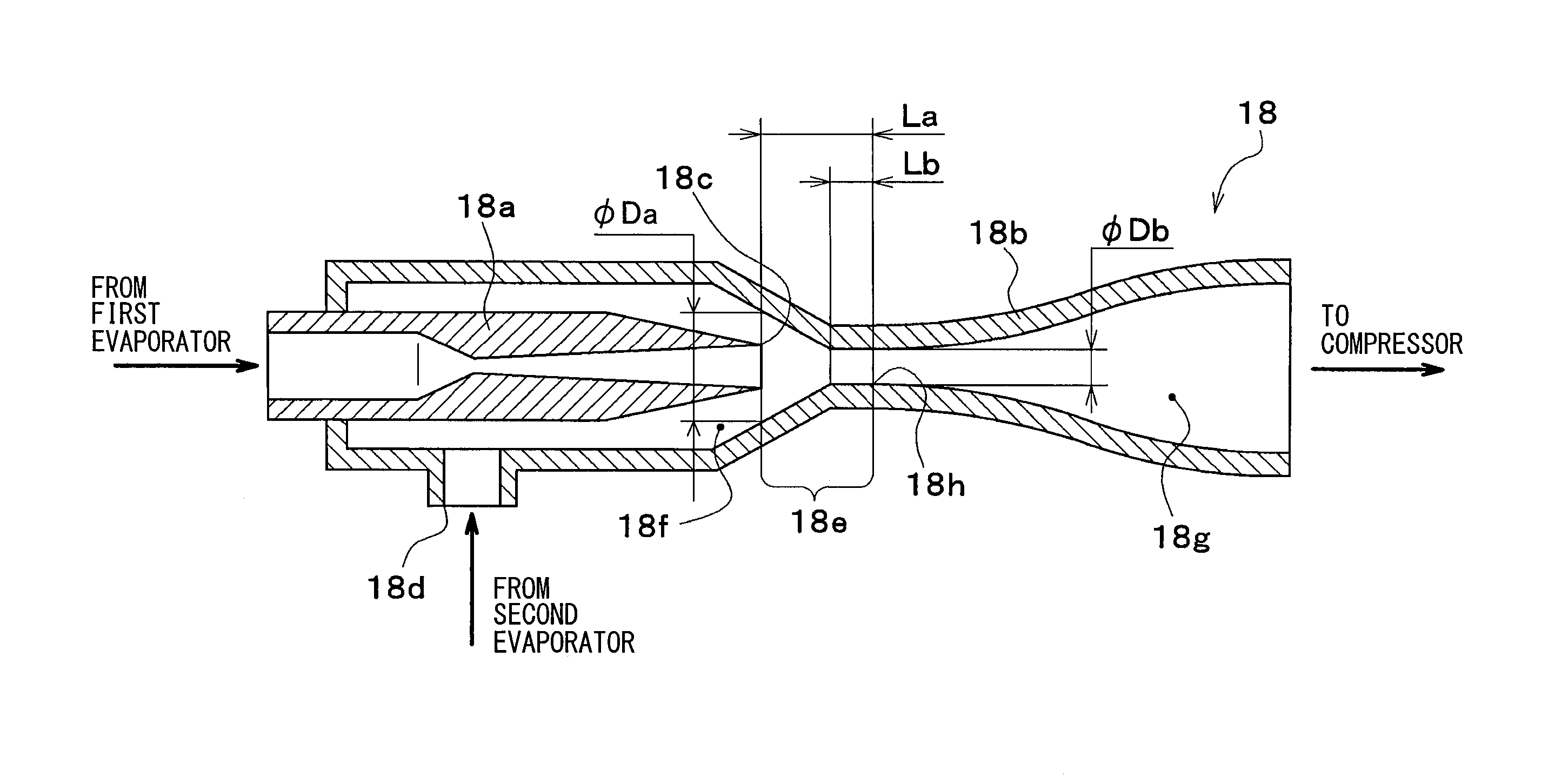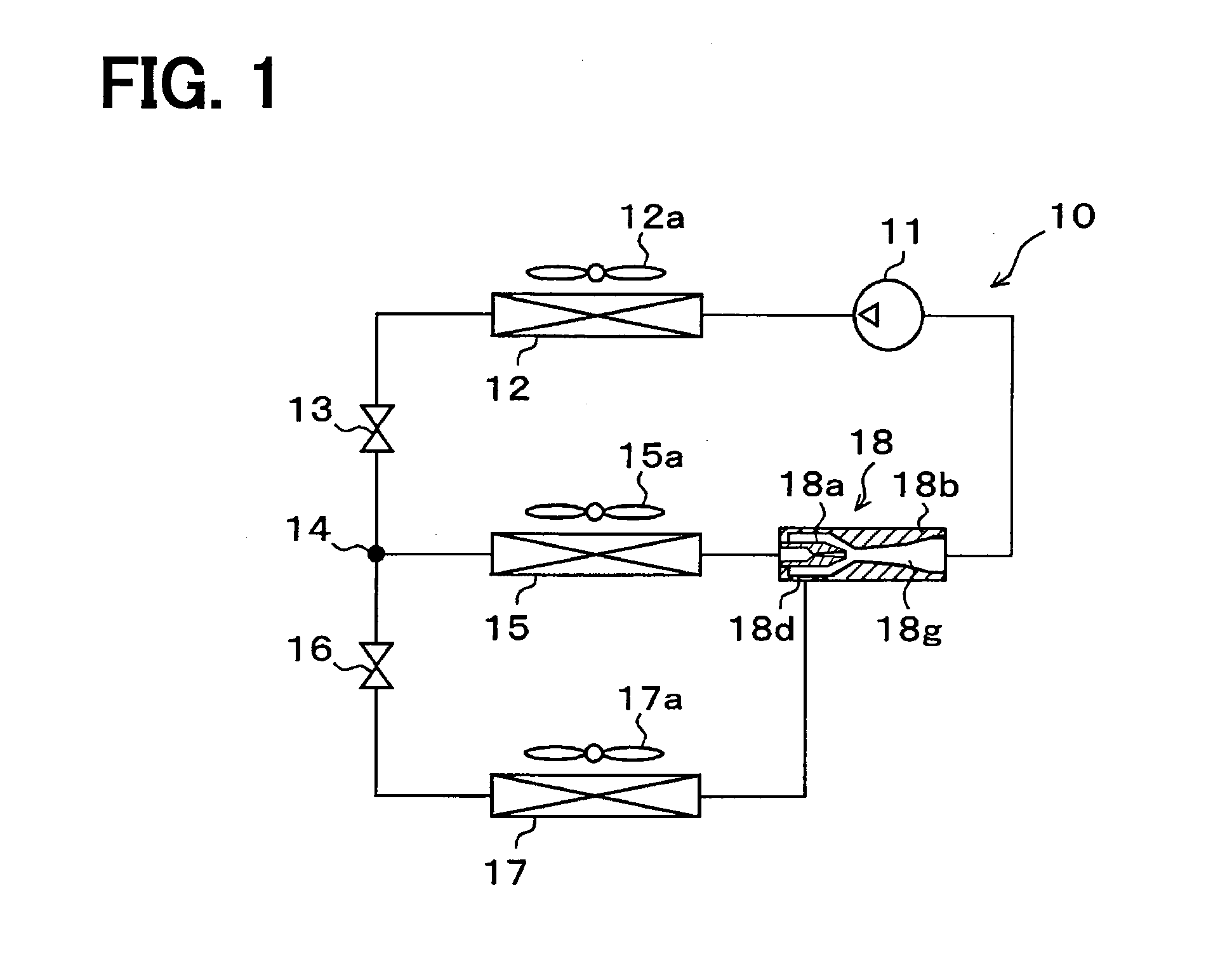Ejector
a technology of ejector and ejector plate, which is applied in the direction of machines/engines, refrigeration components, light and heating apparatus, etc., can solve the problems of not being able to achieve sufficient, and achieve the effect of improving cop and increasing performan
- Summary
- Abstract
- Description
- Claims
- Application Information
AI Technical Summary
Benefits of technology
Problems solved by technology
Method used
Image
Examples
first embodiment
[0070]A description will hereinafter be made on a first embodiment by using FIG. 1 to FIG. 4. In this embodiment, an ejector-type refrigeration cycle 10 that includes an ejector 18 is used as a vehicular refrigeration cycle device. More specifically, the ejector-type refrigeration cycle 10 fulfills a function of cooling vehicle cabin inside air to be blown into a vehicle interior and a function of cooling box inside air to be blown into an in-vehicle refrigerator (i.e., cool box) arranged in the vehicle cabin.
[0071]In the ejector-type refrigeration cycle 10 depicted in an overall configuration diagram of FIG. 1, a compressor 11 draws a refrigerant, compresses the refrigerant until the refrigerant becomes a high-pressure refrigerant, and discharges the refrigerant. More specifically, the compressor 11 of this embodiment is an electric compressor that is configured by accommodating a fixed-capacity-type compression mechanism and an electric motor driving the compression mechanism in a...
second embodiment
[0125]In this embodiment, a description will be made on an example in which a configuration of an ejector 18 is changed as shown in FIG. 5 from that in the first embodiment. In FIG. 5 and other drawings, which will be described below, the same or equivalent portions to those in the first embodiment are denoted by the same reference signs.
[0126]More specifically, in the ejector 18 of this embodiment, a tapered section 18i, in which a refrigerant passage cross-sectional area gradually reduces toward a refrigerant injection port 18c, is formed as a refrigerant passage that is formed in a nozzle portion 18a. That is, the nozzle portion 18a of this embodiment is a so-called tapered nozzle. Furthermore, an injecting section 18j is formed on the lowermost downstream side of the refrigerant passage that is formed in the nozzle portion 18a of this embodiment.
[0127]The injecting section 18j is a space that guides the refrigerant from a downstream most portion of the tapered section 18i toward...
third embodiment
[0139]In this embodiment, a description will be made on an example in which a configuration of an ejector 18 is changed from that in the first embodiment as shown in FIG. 6, FIG. 7. More specifically, in the ejector 18 of this embodiment, a swirl space 18k, in which a refrigerant flowing thereinto from a refrigerant inlet port 18l swirls around an axis of a nozzle portion 18a, is provided on an upstream side, in the refrigerant flow direction, of a throat section (i.e., a minimum passage cross-sectional area section) of a refrigerant passage that is formed in the nozzle portion 18a.
[0140]In detail, the swirl space 18k is formed on the inside of a cylindrical section 18m that is provided on the upstream side in the nozzle portion 18a in the refrigerant flow direction. The cylindrical section 18m constitutes a swirl space forming member described in the claims. Thus, in this embodiment, the swirl space forming member and the nozzle portion are integrally configured.
[0141]The swirl sp...
PUM
 Login to View More
Login to View More Abstract
Description
Claims
Application Information
 Login to View More
Login to View More - R&D
- Intellectual Property
- Life Sciences
- Materials
- Tech Scout
- Unparalleled Data Quality
- Higher Quality Content
- 60% Fewer Hallucinations
Browse by: Latest US Patents, China's latest patents, Technical Efficacy Thesaurus, Application Domain, Technology Topic, Popular Technical Reports.
© 2025 PatSnap. All rights reserved.Legal|Privacy policy|Modern Slavery Act Transparency Statement|Sitemap|About US| Contact US: help@patsnap.com



